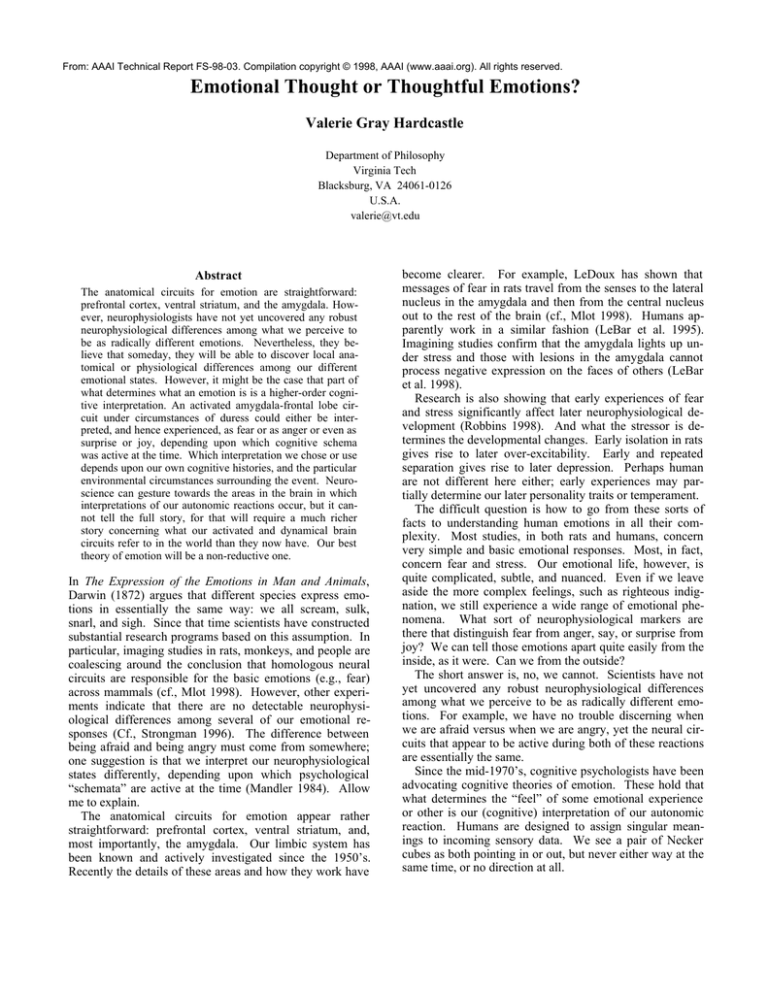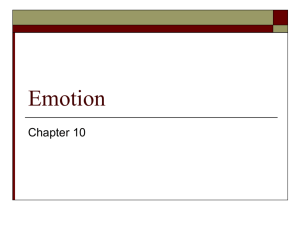
From: AAAI Technical Report FS-98-03. Compilation copyright © 1998, AAAI (www.aaai.org). All rights reserved.
Emotional Thought or Thoughtful Emotions?
Valerie Gray Hardcastle
Department of Philosophy
Virginia Tech
Blacksburg, VA 24061-0126
U.S.A.
valerie@vt.edu
Abstract
The anatomical circuits for emotion are straightforward:
prefrontal cortex, ventral striatum, and the amygdala. However, neurophysiologists have not yet uncovered any robust
neurophysiological differences among what we perceive to
be as radically different emotions. Nevertheless, they believe that someday, they will be able to discover local anatomical or physiological differences among our different
emotional states. However, it might be the case that part of
what determines what an emotion is is a higher-order cognitive interpretation. An activated amygdala-frontal lobe circuit under circumstances of duress could either be interpreted, and hence experienced, as fear or as anger or even as
surprise or joy, depending upon which cognitive schema
was active at the time. Which interpretation we chose or use
depends upon our own cognitive histories, and the particular
environmental circumstances surrounding the event. Neuroscience can gesture towards the areas in the brain in which
interpretations of our autonomic reactions occur, but it cannot tell the full story, for that will require a much richer
story concerning what our activated and dynamical brain
circuits refer to in the world than they now have. Our best
theory of emotion will be a non-reductive one.
In The Expression of the Emotions in Man and Animals,
Darwin (1872) argues that different species express emotions in essentially the same way: we all scream, sulk,
snarl, and sigh. Since that time scientists have constructed
substantial research programs based on this assumption. In
particular, imaging studies in rats, monkeys, and people are
coalescing around the conclusion that homologous neural
circuits are responsible for the basic emotions (e.g., fear)
across mammals (cf., Mlot 1998). However, other experiments indicate that there are no detectable neurophysiological differences among several of our emotional responses (Cf., Strongman 1996). The difference between
being afraid and being angry must come from somewhere;
one suggestion is that we interpret our neurophysiological
states differently, depending upon which psychological
“schemata” are active at the time (Mandler 1984). Allow
me to explain.
The anatomical circuits for emotion appear rather
straightforward: prefrontal cortex, ventral striatum, and,
most importantly, the amygdala. Our limbic system has
been known and actively investigated since the 1950’s.
Recently the details of these areas and how they work have
become clearer. For example, LeDoux has shown that
messages of fear in rats travel from the senses to the lateral
nucleus in the amygdala and then from the central nucleus
out to the rest of the brain (cf., Mlot 1998). Humans apparently work in a similar fashion (LeBar et al. 1995).
Imagining studies confirm that the amygdala lights up under stress and those with lesions in the amygdala cannot
process negative expression on the faces of others (LeBar
et al. 1998).
Research is also showing that early experiences of fear
and stress significantly affect later neurophysiological development (Robbins 1998). And what the stressor is determines the developmental changes. Early isolation in rats
gives rise to later over-excitability. Early and repeated
separation gives rise to later depression. Perhaps human
are not different here either; early experiences may partially determine our later personality traits or temperament.
The difficult question is how to go from these sorts of
facts to understanding human emotions in all their complexity. Most studies, in both rats and humans, concern
very simple and basic emotional responses. Most, in fact,
concern fear and stress. Our emotional life, however, is
quite complicated, subtle, and nuanced. Even if we leave
aside the more complex feelings, such as righteous indignation, we still experience a wide range of emotional phenomena. What sort of neurophysiological markers are
there that distinguish fear from anger, say, or surprise from
joy? We can tell those emotions apart quite easily from the
inside, as it were. Can we from the outside?
The short answer is, no, we cannot. Scientists have not
yet uncovered any robust neurophysiological differences
among what we perceive to be as radically different emotions. For example, we have no trouble discerning when
we are afraid versus when we are angry, yet the neural circuits that appear to be active during both of these reactions
are essentially the same.
Since the mid-1970’s, cognitive psychologists have been
advocating cognitive theories of emotion. These hold that
what determines the “feel” of some emotional experience
or other is our (cognitive) interpretation of our autonomic
reaction. Humans are designed to assign singular meanings to incoming sensory data. We see a pair of Necker
cubes as both pointing in or out, but never either way at the
same time, or no direction at all.
Figure 1: Necker Cubes
These “meanings” are grouped together internally in schemas which we use to parse our world. Which interpretation we chose or use depends upon our own cognitive histories, which shape our schemas, and the particular environmental circumstances surrounding the event. For example, if male college students look at pictures of beautiful
women after exercising, they will interpret their increased
heart rate, etc., as sexual arousal. If they exercise without
the benefit of the pictures, they will interpret the same
changes in heart rate and their autonomic system as physical exertion (Cantor, Zillman, and Bryant 1975). Psychologists argue that we interpret emotional changes in our
bodies in the same way (cf., Strongman 1996). This would
mean that an activated amygdala-frontal lobe circuit under
circumstances of duress could either be interpreted, and
hence experienced, as fear or as anger or even as surprise
or joy, depending upon which cognitive schema was active
at the time.
Most neurophysiologists operate under the reductionist
assumptions that if they probe deeply and carefully enough
into the brain, then they will be able to discover anatomical
or physiological differences among the different emotional
states. In contrast, cognitive psychologists claim that this
sort of reductionist approach cannot work, for part of what
determines what the emotion is is a higher-order cognitive
intervention. The “feel” of the feeling depends upon what
we believe our emotional state should be. Any complete
theory of emotion should reflect our best theories of cognition as well as our best neurophysiological data.
The following deep theoretical questions confront us: In
order to understand the complex emotions of humans fully,
do we need better biological markers, or are some aspects
of emotion going to be fundamentally cognitive, interpretive, higher ordered? At what level of processing in the
mind/brain do emotions occur (and should any artificial
models of emotion track)? Can we reduce emotions and
emotional experiences to particular activated circuits in the
brain, or are these states essentially tied to our understanding of meaning and mindedness?
For now, the best data suggest that the emotions of humans, and most likely other creatures as well, are fundamentally and inescapably tied to our interpretive abilities.
Hence, a purely reductive approach in analyzing them will
miss important aspects of our emotional experiences and
will be less well suited to predict behavior than a more
cognitive model. Nevertheless, claiming that emotions are
partially cognitive does not make them mysterious or exempt from detailed scientific scrutiny. As our appreciation
for brains being systems embedded in a world increases
and we are better able to connect activations in neural networks with meaningful events in the world, then our theories of emotions will become better as well.
In short: emotions are wonderfully recursive phenomena. They shape later cognitive processing, which then
shapes our emotional reactions. At the moment, neuroscience can gesture towards the areas in the brain in which
these events occur, but it cannot tell the full story, for that
would require a much richer story concerning what our
activated and dynamical brain circuits refer to in the world
than they have. Our best theory of emotion will be a nonreductive one.
References
Cantor, J.R., Zillman, D., and Bryant, J. 1975. Enhancement of experienced arousal in response to erotic stimuli
through misattribution of unrelated residual arousal.
Journal of Personality and Social Psychology 32:69-75.
Darwin, C. 1872. The Expression of the Emotions in Man
and Animals. London: John Murray.
LeBar, K.S., LeDoux, J.E., Spencer, D.D., and Phelps,
E.A. 1995. Impaired Fear Conditioning Following
Unilateral Temporal Lobectomy in Humans. Journal of
Neuroscience 15:6846-6855.
LeBar, K.S., Gatenby, J.C., Gore, J.C., LeDoux, J.E., and
Phelps, E.A. 1998. Human Amygdala Activation during
Conditioned Feat Acquisition and Extinction: A MixedTrial fMRI Study. Neuron 20:937-945.
Mandler, G. 1984. Mind and Body: Psychology of Emotion
and Stress. New York: W.W. Norton & Company.
Mlot, C. Probing the Biology of Emotion. Science
208:105-107.
Robbins, T.W. 1998. Neurobiology of Positive Emotions
and Reward Mechanisms. Paper presented at the Fourth
Annual Wisconsin Symposium on Emotion: Affective
Neuroscience, Madison, WI, 17-18 April.
Strongman, K.T. 1996. The Psychology of Emotion: Theories of Emotion in Perspective, Fourth Edition. New
York: John Wiley & Sons.








